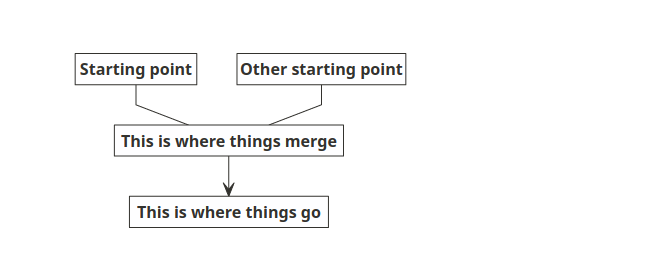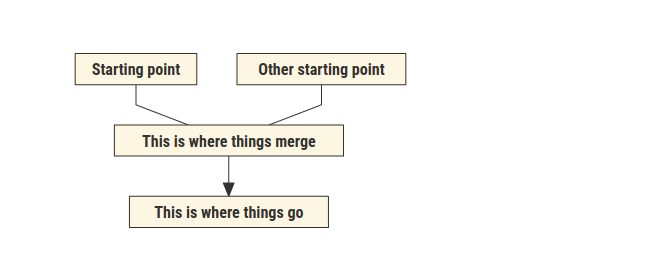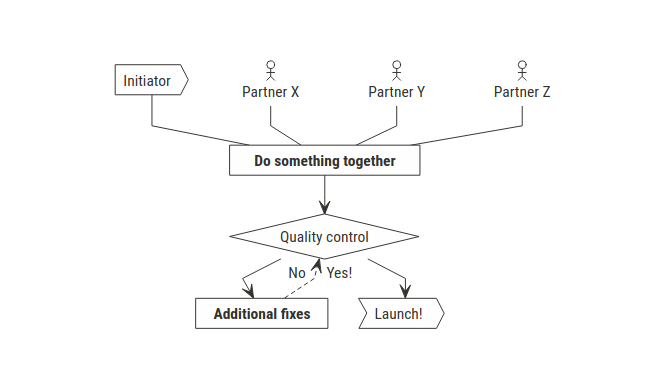The goal of nomnomlgraph is to enable the creation of basic diagrams
such as those created with nomnoml without
having to familiarise with its syntax.
To create a nomnoml diagram with nomnomlgraph you will need two data
frames: one with nodes, the other with edges, in line with the
structure of data tyipically used to generate network graphs.
This facilitates cooperation across teams with members that may be
intimidated by nomnoml syntax and will feel at home in front of a
spreadsheet, or even as a shared spreasheet on Google Drive.
You can install the development version of nomnomlgraph from GitHub:
# install.packages("remotes")
remotes::install_github("giocomai/nomnomlgraph")or from R universe:
install.packages('nomnomlgraph', repos = c('https://giocomai.r-universe.dev', 'https://cloud.r-project.org'))First, you will need a data frame with nodes:
library("nomnomlgraph")
nodes <- tibble::tribble(~id, ~text,
1, "Starting point",
2, "Other starting point",
3, "This is where things merge",
4, "This is where things go")
knitr::kable(nodes)| id | text |
|---|---|
| 1 | Starting point |
| 2 | Other starting point |
| 3 | This is where things merge |
| 4 | This is where things go |
Then one with edges:
edges <- tibble::tribble(~from, ~to, ~association,
1, 3, "-",
2, 3, "-",
3, 4, "->")
knitr::kable(edges)| from | to | association |
|---|---|---|
| 1 | 3 | - |
| 2 | 3 | - |
| 3 | 4 | -> |
Et voilà:
nn_graph(nodes = nodes,
edges = edges)To which you can add a bunch of customisations, see ?nn_graph() for
details. E.g.
nn_graph(nodes = nodes,
edges = edges,
fill = "#fdf6e3",
edgesStyle = "rounded",
font = "Roboto Condensed",
fillArrows = "true",
svg = TRUE)library("nomnomlgraph")
nodes <- tibble::tribble(~id, ~text, ~classifier,
1, "Partner X", "actor",
2, "Partner Y", "actor",
3, "Partner Z", "actor",
4, "Initiator", "sender",
5, "Do something together", "",
6, "Quality control", "choice",
7, "Additional fixes", "",
8, "Launch!", "transceiver")
knitr::kable(nodes)| id | text | classifier |
|---|---|---|
| 1 | Partner X | actor |
| 2 | Partner Y | actor |
| 3 | Partner Z | actor |
| 4 | Initiator | sender |
| 5 | Do something together | |
| 6 | Quality control | choice |
| 7 | Additional fixes | |
| 8 | Launch! | transceiver |
Then one with edges:
edges <- tibble::tribble(~from, ~to, ~association,
4, 5, "-",
1, 5, "-",
2, 5, "-",
3, 5, "-",
5, 6, "->",
6, 7, "No ->",
7, 6, "-->",
6, 8, "Yes! ->")
knitr::kable(edges)| from | to | association |
|---|---|---|
| 4 | 5 | - |
| 1 | 5 | - |
| 2 | 5 | - |
| 3 | 5 | - |
| 5 | 6 | -> |
| 6 | 7 | No -> |
| 7 | 6 | –> |
| 6 | 8 | Yes! -> |
nn_graph(nodes = nodes,
edges = edges,
edgesStyle = "rounded",
font = "Roboto Condensed",
svg = TRUE,
width = 600,
height = 300,
)If you enable set the “output” parameter to “code”, you will get a chunk of text that you can paste directly on nomnoml.com for further adjustments.
nn_graph(nodes = nodes,
edges = edges,
output = "code",
edgesStyle = "rounded"
) |>
cat()
#direction: down
#edges: rounded
#lineWidth: 1
#fill: #FEFEFF
#zoom: 4
#arrowSize: 1
#bendSize: 0.3
#gutter: 5
#edgeMargin: 0
#fillArrows: false
#font: sans
#fontSize: 12
#leading: 1.25
#padding: 8
#spacing: 40
#stroke: #33322E
#title: filename
[<sender>Initiator]-[Do something together]
[<actor>Partner X]-[Do something together]
[<actor>Partner Y]-[Do something together]
[<actor>Partner Z]-[Do something together]
[Do something together]->[<choice>Quality control]
[<choice>Quality control]No ->[Additional fixes]
[Additional fixes]-->[<choice>Quality control]
[<choice>Quality control]Yes! ->[<transceiver>Launch!](remember to use cat() if you are copy/pasting it from the console to
process the new lines)
For more details, see the documentation of the nomnoml package for R:
https://github.com/rstudio/nomnoml/
The original nomnoml: https://nomnoml.com/
This package is distributed under the MIT license.



